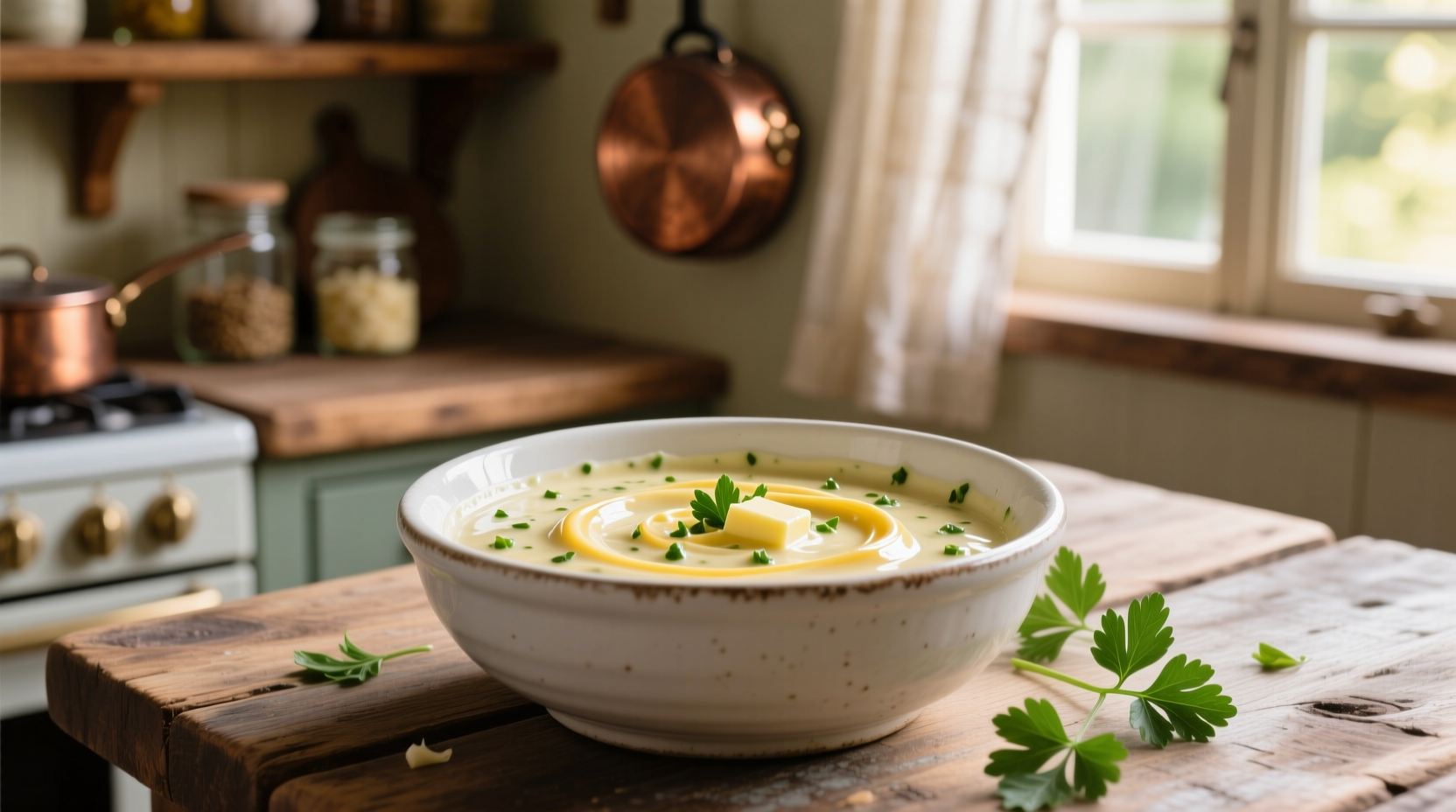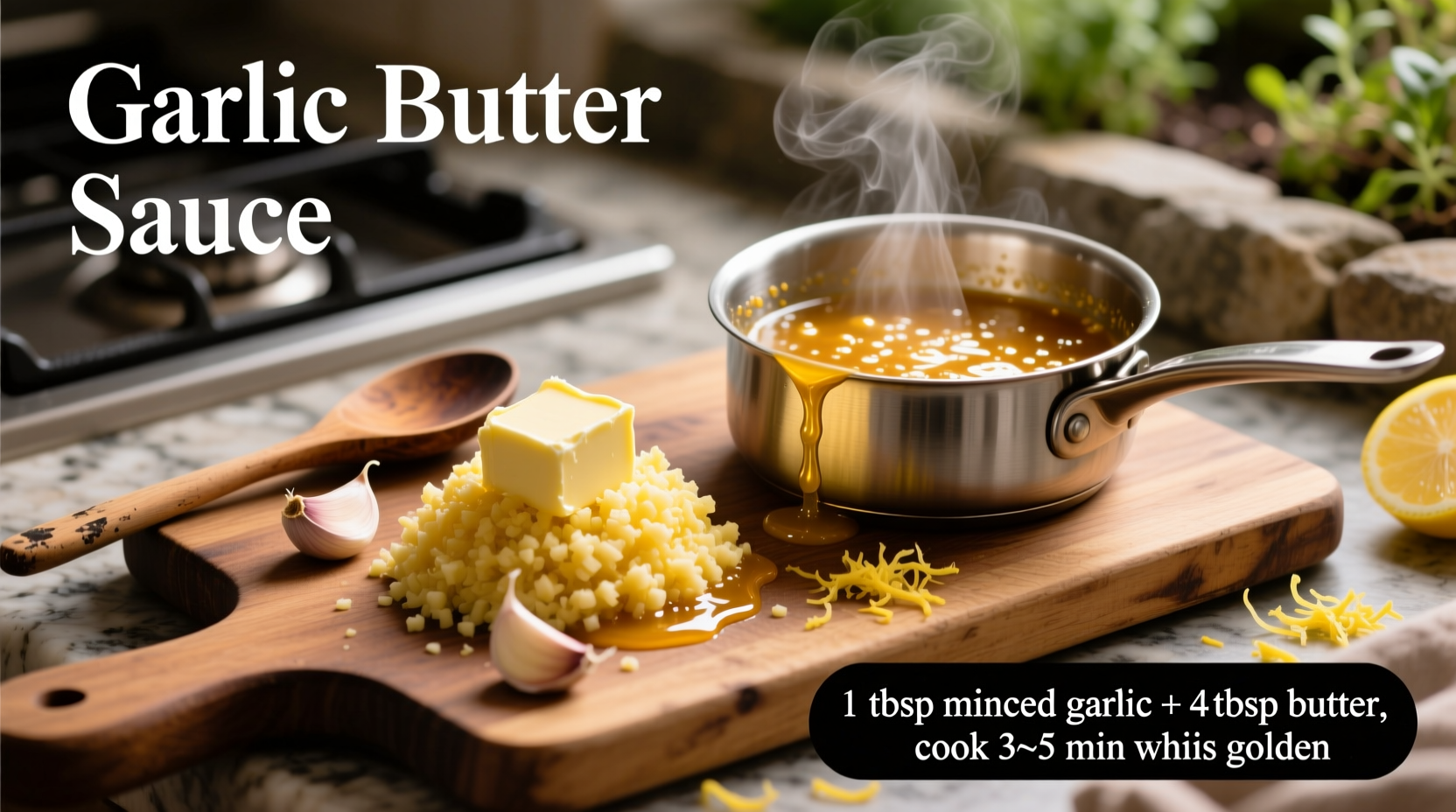Here's how to make perfect garlic butter sauce: Melt 1/2 cup unsalted butter over medium-low heat, add 4 minced garlic cloves, and cook for 1-2 minutes until fragrant but not browned. Remove from heat and stir in 2 tablespoons fresh lemon juice, 1/4 cup chopped parsley, and salt to taste. This simple 5-ingredient sauce takes just 10 minutes and works perfectly with pasta, seafood, chicken, or vegetables.
Garlic butter sauce seems deceptively simple, yet many home cooks struggle to get that perfect balance of rich buttery flavor without burnt garlic. As a professional chef who's taught thousands of home cooks, I've refined this technique through years of testing different methods, temperatures, and ingredient ratios. The secret lies in controlling the heat and understanding garlic's chemical reaction with butter.
Why This Garlic Butter Sauce Method Works
Most failed attempts at garlic butter sauce come from one critical mistake: cooking the garlic too hot or too long. Garlic contains allicin, a compound that gives it that distinctive flavor but turns bitter when exposed to high heat for more than 60-90 seconds. Professional kitchens use a precise temperature window between 250-275°F (121-135°C) to extract maximum flavor without bitterness.
| Garlic Preparation Method | Flavor Result | Best For |
|---|---|---|
| Raw minced garlic | Sharp, pungent, intense | Cold sauces, dressings |
| Sautéed gently (1-2 min) | Sweet, aromatic, balanced | Garlic butter sauce (ideal) |
| Browned garlic | Bitter, acrid, unpleasant | Avoid in butter sauces |
| Roasted whole cloves | Mellow, sweet, complex | Spreadable garlic butter |
This comparison shows why gentle sautéing produces the ideal flavor profile for a classic garlic butter sauce. The Maillard reaction that occurs between 285-320°F creates complex flavors, but exceeding 325°F causes rapid degradation of garlic's delicate compounds.
Perfect Garlic Butter Sauce Ingredients
The beauty of this sauce is its simplicity, but each ingredient plays a crucial role:
- Unsalted butter (1/2 cup) - Using unsalted butter gives you complete control over sodium levels. European-style butter with 82-86% fat content creates a richer emulsion.
- Fresh garlic (4 cloves) - Never use pre-minced garlic from jars; the preservatives create off-flavors. Fresh garlic provides the vibrant, clean taste essential to this sauce.
- Fresh lemon juice (2 tablespoons) - Adds necessary acidity to balance the richness. Bottled lemon juice lacks the bright, complex notes of fresh.
- Fresh parsley (1/4 cup, finely chopped) - Provides color and a subtle herbal note that complements without overpowering.
- Salt (to taste) - Enhances all flavors. Start with 1/4 teaspoon and adjust.

Step-by-Step Garlic Butter Sauce Instructions
Preparation (2 minutes)
Mince your garlic cloves finely but evenly. Uneven pieces will cook at different rates, leading to some being undercooked while others burn. Place minced garlic in a small bowl ready for immediate use. Chop parsley finely - larger pieces can create texture issues in the smooth sauce.
Cooking Process (5 minutes)
- Melt butter in a small saucepan over medium-low heat. Use a light-colored pan to monitor butter's color changes.
- Once butter is fully melted and begins to foam slightly (about 180°F/82°C), add minced garlic.
- Stir constantly for 60-90 seconds until garlic becomes fragrant but remains pale gold. Do not let it brown.
- Remove from heat immediately to stop the cooking process.
- Stir in lemon juice, which will slightly cool the mixture and prevent residual heat from overcooking the garlic.
- Add parsley and salt, stirring to combine.
Proven Variations for Different Dishes
While the basic recipe works universally, these chef-tested variations enhance specific dishes:
- For seafood pasta: Add 1/4 teaspoon red pepper flakes with the garlic and substitute 2 tablespoons of the butter with reserved pasta water for better emulsification
- For steak topping: Include 1 teaspoon Worcestershire sauce and 1 minced shallot cooked with the garlic
- For vegetarian dishes: Replace butter with 1/4 cup olive oil and 1/4 cup butter for a lighter version that still maintains richness
- For extended shelf life: Add 1 tablespoon of cold water after removing from heat, which helps stabilize the emulsion for refrigeration
Storage and Reheating Guidelines
Garlic butter sauce is best used immediately, but can be stored properly:
- Refrigerate in an airtight container for up to 3 days
- Freeze in ice cube trays, then transfer cubes to freezer bags for up to 3 months
- Reheat gently over low heat, never boiling, to prevent separation
- Always reheat with a splash of water or broth to help maintain emulsion
According to USDA food safety guidelines, dairy-based sauces should not remain in the temperature danger zone (40-140°F) for more than 2 hours. When reheating, ensure the sauce reaches 165°F throughout before serving to eliminate potential bacterial growth.
Common Mistakes to Avoid
Even experienced cooks make these critical errors when preparing garlic butter sauce:
- Using high heat - Garlic burns at 325°F, while butter browns around 250°F. Medium-low heat is essential
- Adding garlic to cold butter - This prolongs cooking time, increasing bitterness risk
- Overcrowding the pan - Too much garlic creates steam, preventing proper flavor development
- Using dried herbs - Dried parsley lacks the bright flavor needed to balance the richness
- Skipping the acid component - Lemon juice isn't optional; it balances the fat and enhances garlic flavor
Serving Suggestions for Maximum Impact
This versatile sauce shines with various dishes when applied correctly:
- Pasta: Toss with 1-2 tablespoons of pasta water before adding sauce to help it cling to noodles
- Seafood: Drizzle over grilled shrimp or scallops during the last minute of cooking
- Chicken: Brush on during final cooking stages to prevent burning
- Veggies: Toss roasted vegetables in warm sauce just before serving
- Bread: Serve warm in a small bowl for dipping crusty artisan bread
Professional chefs at the Culinary Institute of America recommend applying garlic butter sauce at the very end of cooking for proteins to preserve its delicate flavor profile. The residual heat will warm the sauce without compromising its fresh taste.
Frequently Asked Questions
Can I make garlic butter sauce without fresh garlic?
While fresh garlic produces the best flavor, you can substitute with 1/2 teaspoon garlic powder. Add it after removing the butter from heat to prevent bitterness. The flavor profile will be less complex but still acceptable for quick meals. Never use pre-minced jarred garlic as the preservatives create off-flavors in the sauce.
Why does my garlic butter sauce separate?
Separation occurs when the emulsion breaks, usually from overheating or adding cold ingredients to hot butter. To fix separation, remove from heat and slowly whisk in 1-2 tablespoons of cold water. For prevention, always add acid and herbs after removing from heat, and maintain proper temperature control during cooking.
How can I make garlic butter sauce last longer?
To extend shelf life, add 1 tablespoon of cold water after cooking to stabilize the emulsion. Store in an airtight container with plastic wrap pressed directly on the sauce surface to prevent oxidation. Properly stored, it lasts 3 days refrigerated or 3 months frozen. Always reheat gently with additional liquid to maintain texture.
Can I use salted butter for garlic butter sauce?
You can use salted butter, but unsalted is preferred for better control over sodium levels. If using salted butter, omit additional salt initially and taste before adjusting. The American Heart Association recommends limiting sodium intake, making unsalted butter the healthier choice for those monitoring salt consumption.
What's the best way to incorporate garlic butter sauce into pasta?
For perfect pasta integration, reserve 1/4 cup of pasta water before draining. Toss cooked pasta with the sauce over low heat, adding splashes of pasta water to help the sauce emulsify and cling to noodles. The starch in the water creates a silky texture that coats each strand evenly, as demonstrated in professional Italian cooking techniques.











 浙公网安备
33010002000092号
浙公网安备
33010002000092号 浙B2-20120091-4
浙B2-20120091-4